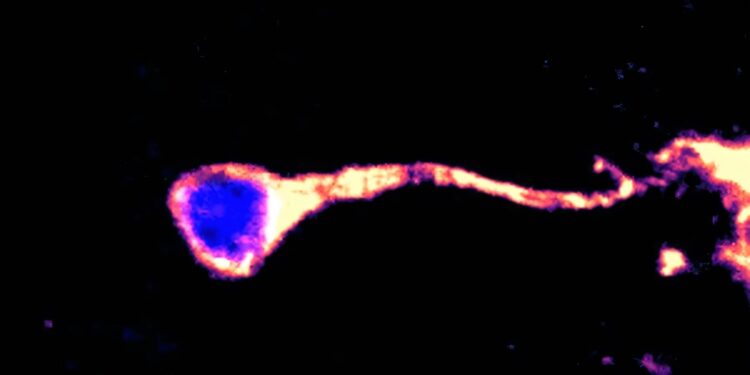Image of a single resting neural stem cell with its characteristic cell protrusion extending from the cell body of the brain of Drosophila larvae six hours after the larvae hatch, with the membrane in orange and the nuclear marker in blue. Credit: Mahekta R Gujar
An international team of neuroscientists, led by Duke-NUS Medical School, has discovered a mechanism that controls the reactivation of neural stem cells, essential for the repair and regeneration of brain cells.
The research, published in Natural communicationsoffers exciting potential to advance our understanding and treatment of common neurodegenerative diseases such as Alzheimer’s disease and Parkinson’s disease.
Neural stem cells are the origin of the main functional cells of the brain. After initial brain development, neural stem cells typically enter a dormant state, thereby conserving energy and resources. They only wake up when the brain needs them, for example after an injury or during physical exercise.
However, with age, fewer neural stem cells can emerge from their dormant state, leading to various neurological conditions. Understanding how this reactivation is regulated is essential for developing treatments for various neurological conditions.
In this study, the team discovered that a specific group of proteins plays a critical role in “waking up” dormant neural stem cells through a process called SUMOylation.
In SUMOylation, a small protein called SUMO (small ubiquitin-like modifier) targets proteins inside a cell to influence their activity and/or function. According to the researchers, these SUMO-tagged proteins trigger the reactivation of neural stem cells, allowing them to contribute to brain development and repair.
Conversely, without the presence of SUMO proteins, fruit flies produced a microcephaly-like phenotype. This is the first study to identify the exact role of the SUMO protein family in neural stem cell reactivation.
Led by Professor Wang Hongyan (second from left) of the Duke-NUS Neuroscience and Behavioral Disorders Program, the research team, including Dr Mahekta Rajeshkumar Gujar (far left), PhD student Lin Jiaen (second from right ) and Dr. Gao Yang (far right), discovered the role of SUMO in waking up dormant neural stem cells. Credit: Duke-NUS Medical School
Dr Gao Yang, a researcher at the Duke-NUS Neuroscience and Behavioral Disorders Program and first author of the study, said: “We have demonstrated for the first time that the SUMO family of proteins plays a central role in reactivation neural stem cells and overall. brain development.
“Going further, we also showed that when these proteins are absent, normal neuronal development is hampered, with fruit flies developing undersized brains, characteristic of microcephaly.”
Digging deeper into the effects of SUMOylation, researchers determined that it regulates a key protein in another well-known pathway, called Hippo. While the Hippo pathway is known to play a crucial role in cellular processes such as cell proliferation, cell death, and organ size, very few regulators of this pathway in the brain are known.
When modified by SUMO, the core wart protein of the Hippo pathway, which limits cell growth and prevents reactivation of neural stem cells, becomes less effective. This allows neural stem cells to grow and divide, forming new neurons that contribute to brain function.
Professor Wang Hongyan, Acting Director of the Neuroscience and Behavioral Disorders Research Program and lead author of the study, said: “Since SUMO proteins and the Hippo pathway are highly conserved in humans, our results are not just about fruit flies. They are also important for understanding human biology.
“Disruptions in the SUMOylation process and the Hippo pathway are linked to various diseases in humans, including cancer and neurodegenerative diseases, such as Alzheimer’s disease and Parkinson’s disease. Our new insights into the role of SUMOylation in the brain opens up exciting new opportunities for interventions that could lead to targeted therapies that harness the body’s own regenerative powers.
Professor Wang and his team had previously demonstrated that fruit fly neural stem cells were an excellent model for unraveling the mysteries of neuronal dormancy, reactivation and regeneration.
Professor Patrick Tan, Senior Associate Dean for Research at Duke-NUS, commented: “This discovery advances our understanding of cell function and control, thereby informing the development of novel regenerative therapies for neurodegenerative diseases. opportunities for developing treatments for neurological conditions such as microcephaly.
“As research continues, we get closer to finding effective ways to help people with these disorders and improve their quality of life.”
More information:
Yang Gao et al, SUMOylation of Warts kinase promotes reactivation of neural stem cells, Natural communications (2024). DOI: 10.1038/s41467-024-52569-y
Provided by Duke-NUS Medical School
Quote: Neuroscientists discover a mechanism capable of reactivating dormant neural stem cells (October 17, 2024) retrieved October 17, 2024 from
This document is subject to copyright. Except for fair use for private study or research purposes, no part may be reproduced without written permission. The content is provided for informational purposes only.



